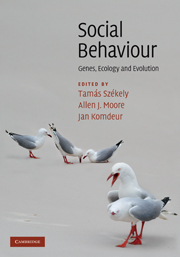Book contents
- Frontmatter
- Contents
- List of contributors
- Introduction: The uphill climb of sociobiology: towards a new synthesis
- Profile: Undiminished passion
- Part I Foundations
- Part II Themes
- 7 Aggression: towards an integration of gene, brain and behaviour
- Profile: From behavioural observations, to genes, to evolution
- 8 Social influences on communication signals: from honesty to exploitation
- Profile: Reputation can make the world go round – or why we are sometimes social
- 9 Important topics in group living
- Profile: A haphazard career
- 10 Sexual behaviour: conflict, cooperation and coevolution
- Profile: In celebration of questions, past, present and future
- 11 Pair bonds and parental behaviour
- Profile: Mating systems and genetic variation
- 12 Adaptations and constraints in the evolution of delayed dispersal: implications for cooperation
- Profile: Selections from a life in social selection
- 13 Social behaviour in microorganisms
- Profile: The de novo evolution of cooperation: an unlikely event
- 14 Social environments, social tactics and their fitness consequences in complex mammalian societies
- Profile: Evolutionary genetics and social behaviour: changed perspectives on sexual coevolution
- 15 Social behaviour in humans
- Profile: Genes and social behaviour: from gene to genome to 1000 genomes
- Part III Implications
- Species index
- Subject index
- References
Profile: Selections from a life in social selection
Published online by Cambridge University Press: 05 June 2012
- Frontmatter
- Contents
- List of contributors
- Introduction: The uphill climb of sociobiology: towards a new synthesis
- Profile: Undiminished passion
- Part I Foundations
- Part II Themes
- 7 Aggression: towards an integration of gene, brain and behaviour
- Profile: From behavioural observations, to genes, to evolution
- 8 Social influences on communication signals: from honesty to exploitation
- Profile: Reputation can make the world go round – or why we are sometimes social
- 9 Important topics in group living
- Profile: A haphazard career
- 10 Sexual behaviour: conflict, cooperation and coevolution
- Profile: In celebration of questions, past, present and future
- 11 Pair bonds and parental behaviour
- Profile: Mating systems and genetic variation
- 12 Adaptations and constraints in the evolution of delayed dispersal: implications for cooperation
- Profile: Selections from a life in social selection
- 13 Social behaviour in microorganisms
- Profile: The de novo evolution of cooperation: an unlikely event
- 14 Social environments, social tactics and their fitness consequences in complex mammalian societies
- Profile: Evolutionary genetics and social behaviour: changed perspectives on sexual coevolution
- 15 Social behaviour in humans
- Profile: Genes and social behaviour: from gene to genome to 1000 genomes
- Part III Implications
- Species index
- Subject index
- References
Summary
Science is about theories and tests of theories, but it is not nearly as dry or as mechanical as that may seem to imply, especially in behavioural ecology. A life in science is also about career choices made, luck, interesting experiences and even fun. Here is a selection from my own career in studying social selection.
Wisest educational choice. Grad school at the University of Michigan. They had a policy of admitting the best students they could, and giving them time to find their advisors and research programme. I found Richard Alexander, though my first real interaction with him was when he thought I might have cribbed ideas for an essay I wrote for his class. Fortunately, as a good scientist, he could change his mind.
Luckiest educational choice. Grad school at the University of Michigan. Though I knew Alexander would be there, I did not know what an inspiring teacher he was. Nor did I know that he would be arranging semester-long visits, in my first three fall semesters at Michigan, by John Maynard Smith, Bill Hamilton and George Williams.
Favourite paper in grad school. Trivers' 1974 paper on parent–offspring conflict turned kin selection on its head by showing that it could describe conflict among relatives. Dick Alexander didn't think it could be true, but he changed his mind there too. This idea, when applied to social insects (first in Trivers & Hare 1976), made them much more interesting.
- Type
- Chapter
- Information
- Social BehaviourGenes, Ecology and Evolution, pp. 328 - 330Publisher: Cambridge University PressPrint publication year: 2010



